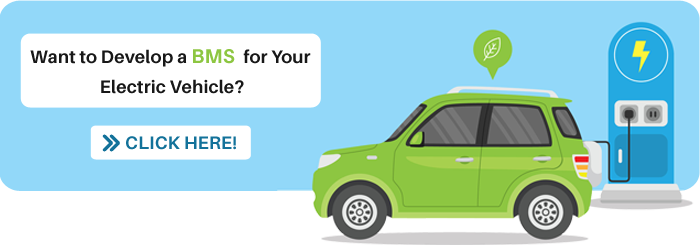Developing a Battery Management System for Electric Vehicles
No matter which city you live in, you might’ve noticed the slow rise of electric vehicles in the automotive industry. A prime requirement for the same would be the battery pack, which accounts for almost 40% of the vehicle’s cost.
The battery is responsible for various functions in your electric vehicle. Therefore, requires constant monitoring. The same can be done using an embedded system known as the Battery Management System (BMS). It’s through the help of a BMS that monitors the cells of your battery, its health, percentage, and more.
Another major reason for the exponential rise in companies investing in the electric vehicle domain is the need to find sustainable transport solutions that don’t harm the environment. One of the first versions of an electric car was designed by Robert Anderson in 1832. Yet, due to the lack of tech, the innovation was put to practical use in 1870.
To get you acquainted with this new concept we decided to write this read that emphasizes the key roles and responsibilities of a BMS in electric vehicles. So, let’s get to it.
Why is it Essential to have a BMS for Electric Vehicles?
A Battery Management System ensures that your battery is healthy, functions efficiently, and performs its operations within safety limits. It learns the state of charge (SOC), optimizes your battery via cell balancing. The other function of a BMS is to collect various data to diminish safety risks.
Battery management is an essential part of almost all electric devices. This is because a BMS can be observed in every high-end device. For instance, your smartphone shows the overall percentage and health of your battery. It’s the algorithms of the BMS that keep a track of all the activities taking place within your battery pack. Yet, when it comes to designing a BMS for electric vehicles the complexity of the same increases exponentially.
One of the rising trends in the industry is wireless BMS. An appealing feature in the e-mobility industry that demands a lot of care too. It uses a single chip to inculcate all the software and hardware parts for power and battery management. This allows the system to incorporate safe and sustainable zero cobalt battery chemistry while supporting maximum power use per cell.
What’s the need for a BMS?
Electric vehicle manufacturers prefer using BMS for lithium-ion batteries having high charge density. The battery packs being small can be highly unstable. Hence, it’s suggested to never overcharge the batteries or test to a deep state of discharge. A condition known as Thermal Runaway can cause the cell temperature to rise on charging or over-charging the batteries.
Such conditions can diminish the capacity and lifespan of your battery. We need a BMS to make sure this doesn’t happen and keep a check on your battery’s current and voltage. To use your battery to its maximum potential it’s essential to charge and discharge the cells simultaneously at the same voltage. This task needs the help of BMS.
Benefits of a Battery Management System
Safety
Electric vehicles use Lithium-ion battery packs. As compared to other batteries Lithium-ion batteries have a higher energy density i.e. 100-265 Wh/Kg. If used following the wrongful practices these batteries can catch fire. Hence, it becomes imperative to use EV batteries within predefined limits.
BMS is responsible to keep a continuous track of your battery’s temperature to ensure proper thermal management. In case of a situation, the safety mechanisms can kick in that minimize operations and cease risks, for eg. Hyundai Kona Electric. The safety mechanisms are put to action when overheating of the battery pack is detected. The output of the vehicle is limited putting the car in a fail-safe mode.
Overheating of Lithium-ion cells can prove to be extremely hazardous, causing thermal runaway and a potential explosion. To avoid overcharging, BMS controls the current supply, prevents overcharging, the voltage of the pack, and individual battery cells.
It also makes sure that the user doesn’t get an electric shock by keeping the vehicle chassis completely isolated.
Cell Monitoring
The battery cells need monitoring due to the continuous charging and discharging of the same. Every activity that takes place should be reported and identified along with the activation of the safety mechanism. Numerous integrated circuits and cell-monitoring circuits make use of algorithms to conduct these functions. It also consists of a cell management controller that receives updates on voltage and temperature recorded by the cell-monitoring circuit.
These algorithms also calculate the state of health (SOH) and state of charge (SOC). It makes sure that a battery is never undercharged or overcharged by regulating the SOC. To a user, this is identified as a fuel indicator as it indicates the remaining power of a battery. As opposed to this SOH is responsible for representing the overall health of the battery and how it is being operated. The lifespan and maintenance of your battery are calculated using this information.
Optimizing Performance
BMS is used to optimize a battery’s performance. The best way to use Lithium-ion batteries is by setting their charge limits between their minimum and maximum capacity. The quality of your battery is degraded by overcharging or undercharging your batteries. BMS decides on the amount of current that is required for charging and communicates the same with the Electric Vehicle Supply Equipment (EVSE) or the Charger.
To avoid cell voltages reach too low, BMS communicates with the motor controller to avoid cell voltages reaching too low. It sends a signal to make the user aware of their battery’s status. Your battery’s recharging through regenerative braking is also controlled by the BMS.
With each charge/discharge cycle, there can be a difference in the individual cell capacity. This imbalance affects the potential of your battery and also the overall charging capacity. In order to maximize the utility of your battery, it’s essential to maintain the cell at equal voltage levels. By measuring the individual cell voltages BMS learns the relative charge balance that is required. Using active and passive balancing techniques, BMS offers cell balancing. It does so by draining excess energy from cells.
Diagnostics
The state of charge (SoC) and state of health (SoH) are represented in percentages to learn the available potential and overall health of your battery. BMS observes any change in behavior or anomalies of the cells with the battery pack. The issues of the battery pack are fixed using the stored error codes and logged diagnostic information. Depending on the situation, BMS can take corrective measures or activate the failsafe mechanisms to preserve the health of the pack.
Communication
BMS conducts the communication with the Electric Control Units (ECUs) of the vehicle. To ensure a vehicle runs smoothly, it collects all data from the battery parameters to the motor controller. While using AC charging, BMS signals the onboard charger to observe and control the charging of the battery pack.
A communication link is established between the EVSE and BMS for DC charging. The required output voltage levels and current levels are communicated to the EVSE by the BMS while also sending signals to start and stop the charging process.
Future of Battery Management System (BMS)
Electric vehicle battery management systems are receiving attention and investments from some of the most renowned firms in the automobile market. One of the most recent contributions to this industry is the wireless BMS. A tech addition that can help EV companies get rid of SPI and CAN BUS cables. The battery being used in these vehicles is getting bigger by the day. Wires can clog the BMS and add to the complexity of the infrastructure. Any compromise with the wires can prove to be hazardous for the users.
In the coming years, we will observe many innovations that are being experimented with concerning Electric Vehicle BMS and related components. These innovations will further support businesses planning to invest in developing EVs. And help governments, stakeholders, AI development companies, and OEMs achieve a dream they’ve been chasing for years.
Wrapping Up
From the number of inquiries we – Technource, an app development company, has received for BMS development, we can surely say that this domain has a great future for the coming years.
If you feel like on-demand solutions are your next venture, you should start researching the same yesterday. Yes, you read it right. Such is the competition to be the supreme contender in this open market, that you would have to act on your toes to get somewhere significant.
Numerous areas require research and development. And these processes can be tedious and time-consuming, therefore you should get to the party. You can get in touch with us by signing up for a free consultation on our website. Our experts will guide you through your entire process i.e. from inception to launch.
Request Free Consultation
Amplify your business and take advantage of our expertise & experience to shape the future of your business.









